Beriev Be-200
The Beriev Be-200 Altair (Russian: Бериев Бе-200) is a utility amphibious aircraft designed and built by the Beriev Aircraft Company. Marketed as being designed for fire fighting, search and rescue, maritime patrol, cargo, and passenger transportation, it has a capacity of 12,000 litres (3,170 US gallons) of water, or up to 72 passengers.[3]
| Be-200 Altair | |
|---|---|
 | |
| Be-200ChS | |
| Role | Multirole amphibious aircraft |
| National origin | Russia |
| Manufacturer | Taganrog Beriev plant |
| Designer | Beriev Aircraft Company |
| First flight | 24 September 1998 |
| Introduction | 31 July 2003 |
| Status | In service, In production[1] |
| Primary user | EMERCOM |
| Number built | 17 [2] |
| Developed from | Beriev A-40 |
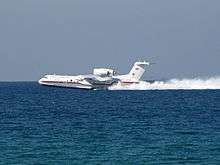
The name Altair was chosen after a competition amongst Beriev and Irkut staff in 2002/2003, as a reference to the name of the alpha star in the Eagle constellation and because: "Al" is the first part of the name of the Beriev A-40 Albatross amphibious aircraft, whose layout was the development basis for the creation of the Be-200; "ta" stands for Taganrog; and "ir" stands for Irkutsk.[4]
Development
The Be-200 was designed by the Beriev Aviation Company, with the Russian Irkutsk Aircraft Production Association (now part of the Irkut Corporation). Beriev are responsible for development, design and documentation; systems-, static-, flight- and fatigue-testing of prototypes; certification and support of the production models. Irkut's duties comprise production preparation; manufacture of tooling; production of four prototypes and production aircraft; and spare parts manufacture.[5] Both companies now fall under the umbrella of the state-owned United Aircraft Corporation.
Initiated in 1989 under the design leadership of Alexander Yavkin, Russian government approval for a purpose-designed water bomber was granted on 8 December 1990. Details of the project were announced, and a model displayed at the 1991 Paris Air Show.[5]
Beriev developed unique fire-fighting equipment for the Be-200, allowing it to scoop water while skimming the water surface at 90-95% of takeoff speed. This system was developed using a specially modified Be-12P, coded '12 Yellow'. After installation of the fire-fighting system, the aircraft was registered RA-00046 and given the designation Be-12P-200. This modified Be-12 was used to develop both the fire-fighting system and methods of operation.[6]
The Be-200's first flight from land was scheduled for 1997, but was eventually achieved by the first prototype aircraft on 24 September 1998.[7] The aircraft was then transferred from Irkutsk to Taganrog after 26.5 flying hours, and the first take off from water was conducted on 10 September 1999 in Taganrog.[8] The second Be-200 flew on August 27, 2002. This aircraft was built as a Be-200ES, being fitted to the specifications of the launch customer, EMERCOM, the Russian Ministry of Emergency Situations.[5][9]
In 2001, as part of a marketing program, the Be-200 was displayed at two large exhibitions in the Pacific Ocean region; the International Maritime and Aerospace Exhibition LIMA'01 in Malaysia and the Korean Aerospace and Defence Exhibition KADE'01 in South Korea.[10]
In 2002, the Be-200 participated in international aviation exhibitions, successfully demonstrating its capabilities to potential customers in France and Greece with 15 demonstration flights made from land, eight from water. A total of over 7,600 km was flown across Europe.[11]
Irkut and EADS signed a memorandum of understanding in May 2002 to jointly carry out a market study and to define the conditions and costs of international certification and the logistics of setting up a worldwide after-sales service. The study was completed in July 2003, revealing a potential market for up to 320 aircraft over 20 years. The two companies, with Rolls-Royce Deutschland, planned to obtain Western certification during 2008/9 and offer a Rolls-Royce BR715 powered aircraft for Western markets.[3][5] This version was to be given the designation Be-200RR. The original Be-200 prototype (RF-21511) was earmarked to be converted into the Be-200RR prototype.[12] However, efforts were discontinued toward a Rolls-Royce version since a joint study concluded in 2004 that because the intended BR715 engine would require extensive redevelopment due to weight and salt-water corrosion issues, break-even would require sales of too many aircraft.[13]
The first production aircraft, a Be-200ES flew on 17 June 2003. It was delivered to EMERCOM on 31 July 2003. Seven aircraft have been ordered by EMERCOM, five have been delivered. The fifth airframe was used for the European certification process which was expected to be completed in 2008. EASA eventually certified the Be200ES-E on 7 September 2010. The remaining two were scheduled for delivery by the end of 2008.[3] EMERCOM has an option to buy a further 8 Be-200s, with a decision expected during the latter part of 2008.[14]
In 2010, production of the Be-200 was decided to switch to the Centre of competence for amphibian aircraft and flying boats in Taganrog. An assembly line was set up using tooling and equipment received from Irkut's main manufacturing site in Irkutsk, Siberia. This will allow the Irkut Corporation to concentrate on other more lucrative projects. Production of the Be-200 will remain under the umbrella of the United Aircraft Corporation.[15] First Taganrog-built aircraft was delivered in early 2017.[16]
In April 2018, Safran and UEC Saturn agreed to re-engine the BE-200 with the PowerJet SaM146 from the Sukhoi Superjet instead of the Progress D-436.[17][18] The hope was that the more-modern SaM146 engine, which has passed international certification and complies with prospective ICAO requirements, will allow the aircraft to be more fully introduced to the European and American markets.[19] One snag was encountered in April 2019 when Russia’s ministry of industry and trade objected to the Be-200ChS-146 project because the new engines contained components from NATO countries.[20] However, the project was apparently only suspended and not cancelled,[20] even though Russian certification of the re-engined aircraft has been pushed to November 2021.[21]
Design
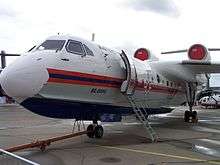
The Be-200 is a high-wing T-tail monoplane. The hull is of single step design with a high length-to-beam ratio, which contributes to stability and controllability in water. The Be-200 airframe is constructed of aluminium alloys with corrosion-protection treatments. Selective use is made of titanium, composites and other corrosion-free materials. The wings are fitted with underwing stabiliser floats. The hydraulically operated retractable landing gear units all retract rearward, and each unit is twin-wheeled. A water rudder provides steering when in the water.[22] It can operate from either a 1,800 m long runway or an area of open water not less than 2,300 m long and 2.5 m deep, with waves of up to 1.3 m high.[3]
The aircraft is powered by two, over fuselage, pylon-mounted Progress D-436TP engines. The D-436TP is a specific "maritime" corrosion-resistant version of the D-436 three shaft turbofan engine, designed especially for the Be-200 amphibian, by Ivchenko Progress ZMKB and manufactured by Motor Sich in Ukraine. These are mounted above the wingroot pods on the landing gear fairings to prevent water spraying into the engines during take-off and landing.[3][22]
The Digital Flight Control (Fly-by-wire) cockpit is fitted with modern navigation systems such as satellite navigation (GPS), FMS, autopilot and weather radar. The ARIA 200-M all-weather integrated avionics system, developed by Honeywell with the Moscow Research Institute of Aircraft Equipment, uses six 152 x 203 mm (6 x 8 in) LCDs to display information to the two-man crew.[22]
The multirole Be-200 can be configured as an amphibious water drop fire-fighting aircraft, a freighter, or as a passenger aircraft—the pressurised and air conditioned cabin allowing transportation of up to 72 passengers. The Be-200 can also be equipped for special missions. When configured as an air ambulance, the aircraft can carry up to 30 stretcher patients and seven seated patients or medical crew. In the search and rescue role, the aircraft can be equipped with searchlights and sensors, an inflatable boat, thermal and optical surveillance systems, and medical equipment. The search and rescue variant can accommodate up to 45 people. The aircraft is also capable of being configured for anti-submarine warfare duties.[3][22]
The Be-200 in amphibious water drop fire-fighter configuration suppresses fires by dropping water contained in eight ferric aluminium alloy water tanks, located under the cabin floor in the centre fuselage section. Four retractable water scoops, two forward and two aft of the fuselage step, can be used to scoop a total of 12 tonnes of water in 14 seconds. Alternatively, the tanks can be filled from a hydrant or a water cistern on the ground. The water tanks can be removed quickly for carrying cargo. Water can be dropped in a single salvo, or in up to eight consecutive drops. The aircraft also carries six auxiliary tanks for fire-retarding chemical agents, with a total capacity of 1.2 m³. The aircraft can empty its water tanks over the site of a fire in 0.8 to 1.0 seconds when flying above the minimum drop speed of 220 km/h (135 mph, 120 kn)[3]
Operational history
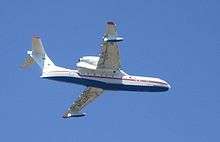
The first documented operational use of the Be-200 was from 20 August till 30 September 2004. For this period a Be-200ES was operated from Sardinia (Italy) by SOREM, the official operator of fire-fighting equipment of Italian Civil Defense Department (Protezione Civile). The aircraft, flown by joint Russian-Italian flight crew performed more than 100 flights with about 90 hours flown. During seven hours of operational flights, the aircraft participated in the extinguishing of four forest fires and dropped 324 tons of water.[23]
The partnership was renewed in 2005, with Be-200ES (Reg. RF-21512) based at Sardinia between July and September. The aircraft flew 150 hours covering 63 missions, including ferry flights, and 435 scoops and drops of water, the total mass of which exceeded 3,175 tonnes (3,500 tons).[24]
In 2006 RF-21512 was leased by the Portuguese Fire Fighting Services (SNBPC – Serviço Nacional de Bombeiros e Protecção Civil) for evaluation during the forest fire season. On 6 July 2006, the Russian crew of the Be-200 leased by Portugal were carrying out a water pick-up from the Aguieira dam near Santa Comba Dão, when on climbing away they clipped treetops and at least one of the Progress D-436TP engines suffered ingestion damage and had to be shut down. The aircraft recovered safely to land at Monte Real air force base, from which it had been operating. After repairs, the aircraft completed the season in Portugal. In total, 42 flights were performed during operations in Portugal, with a total flying time of 119 hours. The aircraft performed 301 water scooping operations and dropped 2,167 tonnes (2,389 tons) of water on fires.[25][26]
In October 2006, two Be-200ES (RF-32765 and RF-32768) were leased to Indonesia by EMERCOM, fighting fires[27] for 45 days.[28] This reportedly cost Indonesia around US$5.2 million.[29] These operations prompted press reports that the Indonesian government had agreed to purchase two Be-200s, each with a projected price of US$40 million.[30] Beriev, however has not confirmed these reports.
Such was the success of the first campaign that two Be-200ES were again leased by Portugal from July 10 to September 30, 2007. During this period 58 fire-fighting flights were conducted with a total flying time of over 167 hours. 2,322 tonnes (2,560 tons) of water was dropped. Beriev claims that representatives of the newly formed Portuguese government enterprise EMA (Empresa de Meios Aéreos) have expressed their interest in a long-term cooperation with Beriev and the Be-200 in Portugal.[31]
Two Be-200ES also operated in Greece, RF-32768 fighting the 2007 forest fires for the whole season and RF-21512 from August 30 to September 13.[32]
In April 2008, Azerbaijan became the first foreign customer for the Be-200, purchasing one Be-200ES from Russia. The aircraft (reg. FHN-10201 ex RF-32769) is operated by the Azerbaijan Ministry of Emergency Situations and can be operated as a fire-fighting, cargo and 43-seater passenger aircraft.[33]
In July/August 2010 it was used in Russia during the wildfires that spread across the country.[34]
In early December 2010, two Be-200ES aircraft were used to fight the 2010 Mount Carmel forest fire near Haifa, Israel.[35][36]
In Serbia one Be-200 belonging to Russian Ministry of Emergency Situations is stationed in summer on Niš Constantine the Great Airport. Aircraft has already operational history in 2012 and 2013.[37]
A Be-200 was dispatched by Russia in January 2015 to assist in search and recovery operations following the loss of Indonesia AirAsia Flight 8501 in the Java Sea.[38] On October 20, 2015, two Be-200s were used by the Indonesian government to fight a forest fire in Sumatra.
In August 2016 two Be-200 aircraft were sent to Portugal after being asked for help in extinguishing forest fires.[39] Four days later it was reported that thanks to the work of the Russian Emergencies Ministry Be-200 pilots, the fire was prevented from spreading in the direction of two settlements: Castro Laboreiro with a population of 1,000 people, and Viaden de Baixo, where 15 farms were saved from fire, and Peneda-Gerês National Park.[40]
China bought two, with an option for two more, of the Be-200 aircraft during the Zhuhai Airshow in 2016. The contract was signed in June 2017.[41]
A firm called International Emergency Services (“IES”), housed at the Santa Maria Public Airport in California, US has been trying for some years to bring the BE-200 to the United States in its fire-fighting role.[42] An organisation called the USA Firefighting Air Corps (“USAFAC”) said in September 2014 that it had signed a collaboration agreement with IES to develop a U.S.-built BE-200 in Colorado;[43] however, while the USAFAC website maintains a BE-200 photo, no further information is provided on the status of the project.[44] There was also discussion at a Santa Maria Public Airport District meeting in October 2016 of IES, Seaplane Global Air Services (“SGAS”) and Airbus partnering to build the aircraft at the Santa Maria airport.[45] Meanwhile, in September 2018, SGAS ordered from the manufacturer four Be-200ES aircraft with an option for six more. The first two aircraft will be equipped with D-436TP engines, the eight others with the SaM146 engines.[46] According to some reports, SGAS has plans to wet- and dry-lease the water-bombers in partnership with IES, offering services in several countries, including the US, European nations, and Australia.[47]
Variants
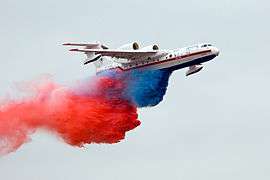
- Be-200
- Basic multirole model
- Be-200ChS/Be-200ES
- Multirole model fitted to the requirements of the Russian Ministry of Emergency Situations
- Be-200E
- English cockpit version of the Be-200ES[48]
- Be-200RR
- Projected Rolls-Royce engined variant,[12] since shelved[13]
- Be-210
- Projected passenger-only model[49]
- Be-220
- Projected maritime patrol variant[50]
- Be-200ChS-146
- Projected SaM146-powered variant[21]
Operators
- Ministry of Emergency Situations – 1 Be-200ES in inventory.[51]
- Beriev Aircraft Company – 1 Be-200 (RA-21511) and 1 Be-200ChS (No.: 21512).[52] As of 2019, RA-21511 is located at the Beriev manufacturing plant in Taganrog[53] and No.: 21512 is in active use.[54]
- Ministry of Emergency Situations – ordered 8 Be-200ESs in 2010.[55] It had 12 Be-200ESs in inventory as of February 2019.[51][56][57]
- Ministry of Defence – ordered 3 Be-200ESs in 2018. The first one was delivered on July 14, 2020.[58]
Future operators
- Seaplane Global Air Services – 4 Be-200ESs on order and 6 options (the first 2 on order with D-436TP engines, all others with the SaM146 engines).[46] The agreement provides for deliveries to begin 15 months after the financing starts, and the financing was anticipated in September 2019. Deliveries were expected to start in late 2020 and continue into 2021;[61] however, Russian certification of the SaM146-powered aircraft is not now anticipated before November 2021.[21]
Specifications (Be-200)
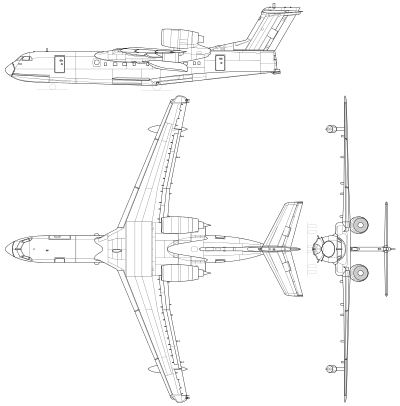
Data from Irkut Website[3] and EADS-Irkut Seaplane Website[22]
General characteristics
- Crew: 2
- Capacity: 44 pax Be-200ES / 72 pax Be-210 / 7,500 kg (16,535 lb)) cargo payload / 12,000 kg (26,455 lb)) water or retardant
- Length: 32 m (105 ft 0 in)
- Wingspan: 32.8 m (107 ft 7 in)
- Height: 8.9 m (29 ft 2 in)
- Wing area: 117.4 m2 (1,264 sq ft)
- Airfoil: root: TsAGI 16% ; tip: TsAGI 11.5%[63]
- Empty weight: 27,600 kg (60,848 lb)
- Max takeoff weight: 41,000 kg (90,390 lb) (land)
- Max Take Off Weight (Water): 37,900 kg (83,555 lb))
- Powerplant: 2 × Progress D-436TP turbofan engines, 73.55 kN (16,534 lbf) thrust each
Performance
- Maximum speed: 700 km/h (430 mph, 380 kn)
- Cruise speed: 560 km/h (350 mph, 300 kn)
- Economy cruise speed: 550 km/h (340 mph; 300 kn)
- Landing speed: 200 km/h (120 mph; 110 kn)
- Takeoff speed: 220 km/h (140 mph; 120 kn)
- Minimum speed (Flaps 38°): 157 km/h (98 mph; 85 kn)
- Range: 2,100 km (1,300 mi, 1,100 nmi)
- Ferry range: 3,300 km (2,100 mi, 1,800 nmi) with 1 hour reserve
- Service ceiling: 8,000 m (26,000 ft)
- Rate of climb: 13 m/s (2,600 ft/min) at Sea Level, MTOW and Flaps 20°
- 17 m/s (55.8 ft/s) at Sea Level, MTOW and Flaps 0°
Avionics
ARIA 200-M integrated avionics system.
See also
Related development
Aircraft of comparable role, configuration and era
- Bombardier 415
- ShinMaywa US-2
- AVIC TA-600
Related lists
References
Notes
- "ТАНТК передал МЧС России первый серийный самолет Бе-200ЧС". armstrade.org. 2017-01-12.
- "Бериев Бе-200". russianplanes.net. Retrieved August 12, 2019.
- "Irkut—Be 200". Archived from the original on 2008-09-25. Retrieved 2008-08-04.
- "PRESS RELEASE No.58 dt. 12th February 2003. Results of the competition for the best personal names for the Be-103 and the Be-200 amphibious aircraft".
- "Defense & Security Intelligence & Analysis: IHS Jane's - IHS".
- Gordon, Sal'nikov and Zablotskiy 2006, pp. 79-80.
- "PRESS RELEASE No.58 dt. 12th February 2003. Results of the competition for the best personal names for the Be-103 and the Be-200 amphibious aircraft".
- "PRESS RELEASE No.58 dt. 12th February 2003. Results of the competition for the best personal names for the Be-103 and the Be-200 amphibious aircraft".
- "PRESS RELEASE".
- "PRESS RELEASE No.58 dt. 12th February 2003. Results of the competition for the best personal names for the Be-103 and the Be-200 amphibious aircraft".
- "PRESS RELEASE".
- Gordon, Sal'nikov and Zablotskiy 2006, pp. 87-88.
- "R-R-powered Be-200 faces uncertain future". Flight International. 2004-12-21. Retrieved 2017-01-26.
- Flightglobal—Russia's OAK in bid to boost sales of Be-200
- Flightglobal—Russia sets up central production site for amphibious aircraft
- http://armstrade.org/includes/periodics/news/2017/0112/145539049/detail.shtml
- "UEC to re-engine Beriev amphibian with SaM146 in 2020 - Russian aviation news". Russian Aviation Insider. 2018-04-05. Retrieved 2018-05-16.
- Michael Gubisch (25 May 2018). "Russian Be-200 firefighter to be updated with Superjet engines". Flightglobal.
- "Russian-French SaM146 Engine for Be-200 Amphibious aircraft". Defense World.net. 9 September 2018. Retrieved 19 December 2018.
- "Russian ministry blocks SaM146-powered Beriev amphibian project". Russian Aviation Insider, April 11, 2019. Retrieved June 17, 2020.
- "BE-200 Aircraft with SaM-146 Engines to be Certified in H2 2021". Russian-American Business, November 23, 2019. Retrieved June 17, 2020.
- "EADS-Irkut Seaplane—Be-200". Archived from the original on 2007-03-17. Retrieved 2008-08-04.
- "Press release".
- "Press release".
- "Press release".
- Flightglobal—Russian firefighting Be-200 under evaluation by Portugal stokes forest fire by dumping fuel
- See 2006 Southeast Asian haze for more details on the 2006 fires in Indonesia
- "Irkut—News". Archived from the original on 2007-03-17. Retrieved 2008-08-26.
- Antara News Agency (November 2, 2006)—Two Russian water bombing aircraft to be operated for 10 days in Sumatra
- "Angkasa No.06—March 2007". Archived from the original on 2008-09-29. Retrieved 2008-08-26.
- "Press release".
- "Press release".
- "Press release".
- Лесные пожары в России (Выкса, Воронеж, Рязань и др.): свидетельства очевидцев, фото, видео Archived 2010-08-02 at the Wayback Machine hvylya.org 30.07.2010 10:21
- EMERCOM planes start putting out fires in Israel
- "Russia sends another Be-200 to fight Haifa blaze". 5 December 2010. Archived from the original on 18 August 2016.
- "Ruski piloti iz Niša vode bitku sa požarima u Srbiji". 27 November 2015.
- "Russian Divers Begin Search for Black Boxes From AirAsia QZ8501". Sputnik. 4 January 2015. Retrieved 10 January 2015.
- "Russia Provides Two Be-200 Aircraft on Portuguese Fire-Fighting Mission". sputniknews.com. sputniknews. Retrieved 18 August 2016.
- "Russian Emergencies Ministry's Be-200 Aircraft Put Out 2 Fires in Portugal". sputniknews.com. sputniknews. Retrieved 18 August 2016.
- "Chinese customer confirms order for Beriev amphibian airplanes - Russian aviation news". 2017-06-29.
- "IES Website". Retrieved 2018-07-18.
- "Colorado Company will Build Russian-Designed Firefighting Planes, dated 9-29-14". Retrieved 2018-07-18.
- "USAFAC Website". Retrieved 2018-07-18.
- "Russian seaplanes to be built in Santa Maria, California". The Website of the City of Taganrog (Russia). October 28, 2016. Retrieved October 25, 2019.
- "Seaplane Global Air Services orders 10 Be-200ES amphibious aircraft". airrecognition. 10 September 2018. Retrieved 12 September 2018.
- "US company scoops up Russian Beriev Be-200 firefighting amphibians". Russian Aviation Insider. 21 September 2018. Retrieved 19 December 2018.
- "EADS-Irkut Seaplane—Be-200E". Archived from the original on 2010-06-26. Retrieved 2008-08-05.
- "EADS-Irkut Seaplane—Be-210". Archived from the original on 2007-03-17. Retrieved 2008-08-05.
- Gordon, Sal'nikov and Zablotskiy 2006, p. 92.
- "Бе-200". russianplanes.net. Retrieved 19 June 2019.
- "МЧС РФ ДОЛЖНО ПОЛУЧИТЬ ЕЩЕ ОДИН БЕ-200ЧС В ТРЕТЬЕМ КВАРТАЛЕ 2009 Г." aviaport.ru. 13 January 2009. Retrieved 19 June 2019.
- "Бериев Бе-200 Бортовой №: RA-21511". russianplanes.net. Retrieved 19 June 2019.
- "Бериев Бе-200ЧС Бортовой №: 21512". russianplanes.net. Retrieved 19 June 2019.
- "Russian Emergencies Ministry buys eight Be-200 aircraft to tackle wildfires". Sputnik (news agency). 9 September 2010. Retrieved 19 June 2019.
- "Новый серийный Бе-200ЧС передан МЧС России". armstrade.org. 7 September 2018. Retrieved 19 June 2019.
- "ТАНТК им. Г.М.Бериева передал МЧС РФ очередной серийный самолет-амфибию Бе-200ЧС". armstrade.org. 27 February 2019. Retrieved 19 June 2019.
- https://www.airrecognition.com/index.php/news/defense-aviation-news/2020/july/6440-russian-navy-receives-its-first-be-200es-amphibious-aircraft.html
- "Beriev wins separate deals for up to 15 Be-200s". Flight Global. 10 September 2018. Retrieved 19 June 2019.
- https://mobile.twitter.com/UAC_Russia_eng/status/1140922018851950593
- "United Aircraft Corporation will start delivering the Be-200 amphibious aircraft to US and Chile". Russian Aviation. June 18, 2019. Retrieved October 25, 2019.
- "Россия продала в Китай самолеты-амфибии Бе-200". lenta.ru. 2 November 2016. Retrieved 19 June 2019.
- Lednicer, David. "The Incomplete Guide to Airfoil Usage". m-selig.ae.illinois.edu. Retrieved 16 April 2019.
Bibliography
- Yefim Gordon, Andrey Sal'nikov and Aleksandr Zablotskiy (2006). Beriev's Jet Flying Boats. Hinckley, UK: Midland Publishing. ISBN 1-85780-236-5.
External links
| Wikimedia Commons has media related to Beriev Be-200. |
- Beriev (Aircraft Designer) Official Site
- Irkut (Aircraft Manufacturer) Official Site
- EADS-Irkut Seaplane (Aircraft Sales & Marketing Partners) Official Site
- RussiaToday: Spotlight - Be-200—Russia's aviation breakthrough—An interview with Oleg Demchenko, President of the Irkut Aviation Corporation, about the Be-200, its lack of European sales, and the state of the Russian aviation industry.
- "Mixing Fire and Water"—a 1998 Flight article on the Beriev BE-200
- Beriev, Be-200 Multipurpose amphibian aircraft
- Russia to create several Be-200 amphibious aircraft units, August 2020